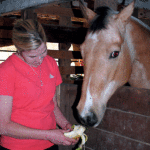 Credit: Thinkstock Photo
Credit: Thinkstock PhotoMost of the country is experiencing the throws of winter with cooler temperatures and high moisture content in the air. Long hair coats and blankets worn round the clock provide a perfect environment for fungi to flourish, especially if your horse gets wet. Commonly, a horse may sweat underneath a blanket or a blanket may fail and let moisture through to the skin. Body heat can then incubate fungal hyphae, which then rapidly grow.
Most of us are familiar with the signs of skin fungal infection or “rain rot”- it causes hair loss and itchy, red skin. The hair comes off in clumps and literally breaks off at the root with a kind of dusty, crumbly powder being left behind. Sometimes the horse’s coat will even smell like mildew. Rain rot can pop up just about anywhere on the body and in extreme cases, can become fulminant. There is nothing more for a horse (and its owner) than having to walk around looking like a lizard! Here are some tips on managing rain rot:
1. When over the counter medicated shampoos and sprays are not doing the trick, move to more powerful products available through your veterinarian. Fungal hyphae can be incredibly resilient but can respond well to antifungal medications such as chlorhexidine or ketoconazole.
2. If you use betadine scrub to treat fungal infections use caution and be mindful that betadine used daily will dry skin out and create its own problems.
3. Air out blankets since most of the time the fungal hyphae incubate and replicate in an environment with little oxygen.
4. Spray athletes foot spray on the inside of blankets. It is an antifungal and can slow down the rate of hyphae growth.
5. Consider having two blankets for your horse so that you can launder each regularly but still keep your horse protected from the weather.
6. Wash saddle pads and clean tack regularly since they can both serve as physical vectors for fungal spread.
7. Grooming your horse daily will reduce rain rot because it physically removes fungal spores from your horse’s coat.
8. Routinely clean brushes by letting them soak in water with dilute bleach (usually 1 part bleach to 9 parts water will do the trick if you soak for 2 or more hours.)
9. Don’t share blankets, saddle pads, tack or grooming equipment with other horses- sharing can potentiate the spread of fungus.
10. Bathing horses in medicated shampoo may not be possible this time of year due to weather constraints. In this situation, treating fungus “hot spots” with medicated sprays or ointments is the next best thing. Veterinarians all have their favorite brands- consult your vet to find out which topical treatment would be best for your horse.
With winter solstice just past, we are on our way back to warmer weather… eventually. For the time being, keep your horse’s skin as healthy as possible by following the tips above.







